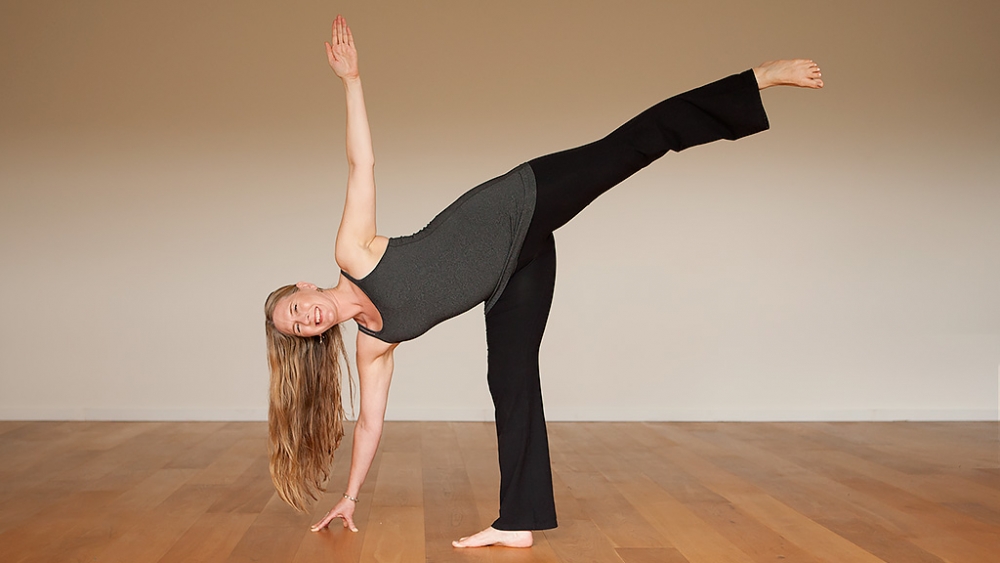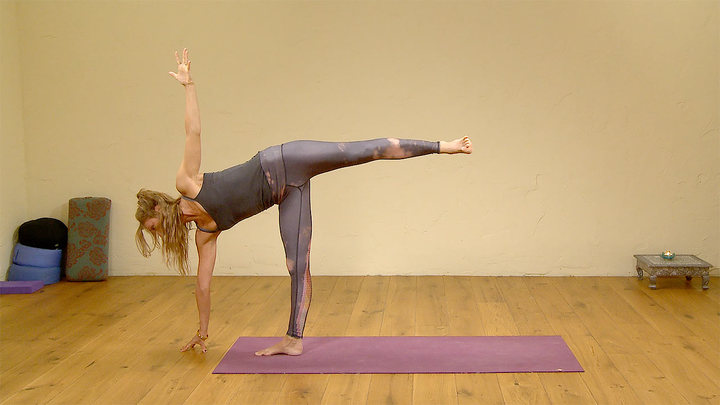Half-Moon pose or Ardha Chandrasana is a great standing balance which will strengthen and energise the whole body, especially when you get chance to practise it slowly, spending time setting up and staying in the pose.
I am very fond of this pose, largely thanks to an amazing class I had years ago where we spent the entire class just working on this one pose. My legs felt like I had run a marathon the next day but I learned so much and it took away that psychological reaction (ie fear!) that can sometimes come up when the teacher announces a particular pose. As a result I find myself practising it a lot.
These tips are really more like principles which you can apply to all kinds of yoga poses but I have found them especially helpful for making Half-Moon steadier, lighter and more fun.
1. Balance strength and flexibility
While you are looking for the perfect balance of strength and ease or Sthira and Sukha in every asana, I think Half-Moon pose is a lovely example of why this is important. It requires expansion and softness but lots of stability too. Stiffen up too much and you run the risk of toppling over, possibly into some form of elaborate cartwheel. Not enough stability or “too much” flexibility and the tendency is for the back to bend, especially if you have a lot of movement in your pelvis.
Engaging the transverse abdominals (the band of deeper abdominal muscles crossing from hip point to hip point) will help the pose be more stable and also aligns the pelvis so that there is more space between the outer hip and the thigh bone.
- Sandra Carson talks about how to create this stability in the pelvis and the core of the abdomen in her Half-Moon alignment class
Also, think about the oblique muscles on the sides of your waist. This was one of main lessons I learned in that wonder class. Aim to keep equal length from your hip to shoulder on both sides of your body. These obliques can get a little left out in yoga sometimes but engaging and strengthening them will really help with balance poses. Work on your obliques with side stretches using hand weights, core bicycles (sit-ups bringing the elbow to opposite knee), Side Planks and of course…lots of Half-Moon pose practise.
2. Remember what you can’t see
Every yoga pose has its own Drishti, a point for the eyes to softly focus on. Drishtis are especially helpful to keep you balanced in poses like Half-Moon. It’s also important to ‘view’ what you can’t see though, like having a sense of where your back arm is in Warrior 2 or the outer edge of the back foot in Triangle pose. In Half-Moon pose it is the lifted leg we need to keep in mind. The toes should be pointing to the side with the foot flexed and the leg should be in line with the spine, rather than moving to the back of the body. Focus on creating length, pushing out through the sole of the lifted foot, rather than how high you can lift the leg.
- Watch Adela Serrano’s class for lots more teaching points on this theme: Paying attention to the back leg in standing poses
3. Apply the press-rebound principle
Whilst all the weight in the pose is obviously in your standing leg you can avoid feeling like everything is compressing down on your hip joint by applying the press-rebound principle. Exaggerate pushing through the standing leg foot and feel the force bounce back upwards through the leg and up to the top hand. This will help you feel lighter in the pose and helps to protect the joints. Use the same principle for the lifted leg: imagine pressing the foot against a wall (or use a real one) and feel the rebound help to maintain length in your spine and neck. Pushing out also takes out some of the effort of keeping the leg lifted. Take it easy though – overenthusiastic pressing against a wall, real or otherwise, can send you shooting forwards as I have discovered.
- To explore the principles of grounding watch Katy Appleton’s class: Root to fly
4. Still your chattering mind
Outside of meditation, nowhere am I more aware of the fluctuations of my ‘chattering mind’ than in balancing poses! Just becoming aware of the chatter, particularly any negative automatic thoughts, is a good start. You can also imagine turning down the volume or watching the thoughts pass by without getting involved with them. Mindfulness training is a great way to practise this.
I also find it helps to visualise myself in the pose shining a light onto different areas I need to pay attention to in turn, rather than using words to talk myself through a pose. So for Half-Moon pose I imagine ‘lighting up’ my standing foot, then pelvis, side waists, the sole of my raised foot, the side of my neck and my top hand.
- Esther Ekhart explores the sutra Yoga Chitta Vritti Nirodha (Yoga Sutras of Patanjali 1.2), meaning “yoga is the cessation of the fluctuations of the mind” in Freedom series: Containment and Balance
5. Have some fun
I love yoga, of course, but sometimes it can all get a little bit serious. Bring some play in your practice. Experiment with lifting the bottom hand away from the floor, allow yourself to wobble or fall and laugh it off. When no one is around I use Half-Moon pose to pick things up from the floor – every little helps 😉
Try coming into the pose in different ways. If you are used to transitioning into Half-Moon from Warrior 2, just for a change try coming into the pose from the top down instead as if ‘tipping’ into it from Triangle pose.
- Get some ideas from Anat Geiger in her class Half Moon flow where she comes into the pose from three different angles. Have fun with her brilliantly named Sideways Flying Dragon – flying between two mountains!
Try it in class
EkhartYoga members can watch Marlene Henny’s short Half-Moon pose tutorial
For step by step instructions for Half-Moon pose visit the pose library where you’ll also find advice for beginners, variations and more.


